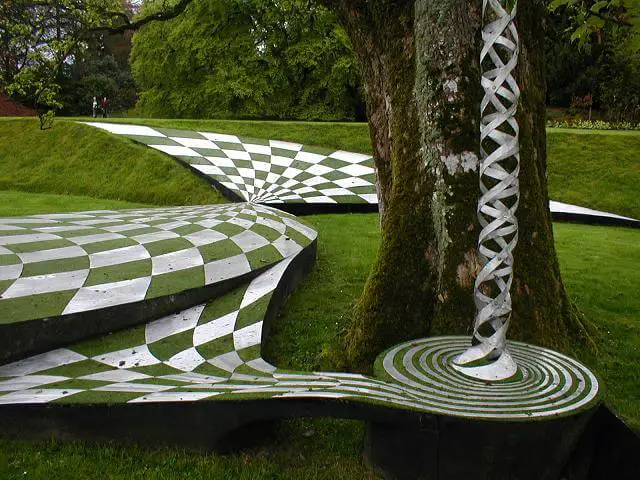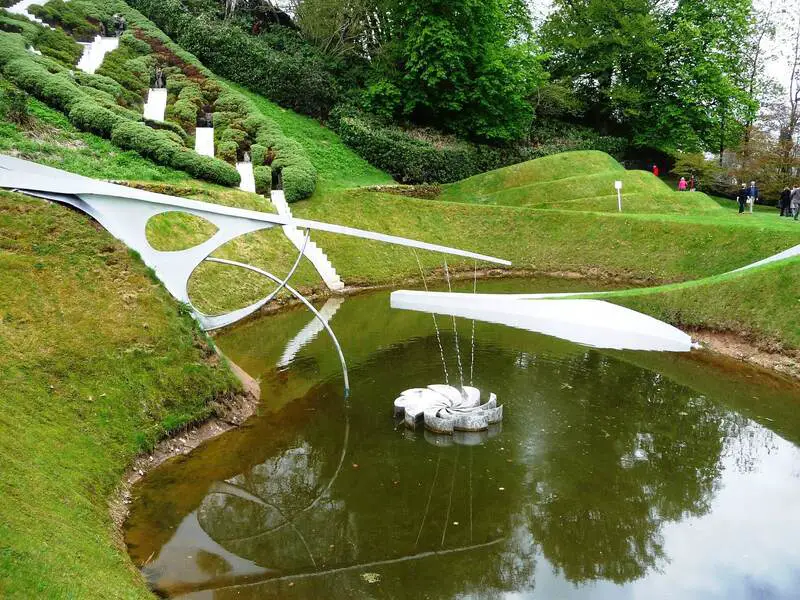Located in Dumfriesshire, Scotland, the Garden of Cosmic Speculation is a unique and intriguing garden designed by landscape architect Charles Jencks. This garden was created to reflect the universe and modern science, with a design that combines art, science, and nature. In this article, we will explore the five most interesting aspects of this unusual and fascinating garden.
Scientific Foundations of the Garden of Cosmic Speculation
The Garden of Cosmic Speculation is unique in the sense that it is not only a beautiful garden but also a work of art that is based on scientific concepts. The garden’s creator, Charles Jencks, was a landscape architect and theorist who had a deep interest in science and mathematics. He used his knowledge to create a garden that reflects his passion for science and art.
One of the key scientific concepts that inspired the design of the garden is chaos theory. Chaos theory is a branch of mathematics that deals with complex systems that are highly sensitive to initial conditions. Jencks used chaos theory to create the Landform Ueda, which is a large earthwork that is shaped like a DNA helix. The earthwork is surrounded by a series of pools and waterfalls, which represent the concept of DNA replication.
Another scientific concept that is reflected in the garden is fractal geometry. Fractal geometry is a branch of mathematics that deals with the repetition of patterns at different scales. The Fractal Terrace area of the garden is an example of how fractal geometry can be used in landscape architecture. The terrace features a series of repeating patterns that create a sense of order and harmony.
The Black Hole Terrace is another area of the garden that is based on a scientific concept. The terrace represents the phenomenon of a black hole in astronomy. The use of mirrored symmetry in this location creates an illusion of infinite depth, creating an impressive atmosphere that invites visitors to contemplate the vastness of space and time.
Overall, the scientific foundations of the Garden of Cosmic Speculation are an essential part of what makes it such a unique and fascinating place to visit. By blending science and art, Charles Jencks has created a garden that is not only beautiful but also intellectually stimulating. Whether you’re a science enthusiast or simply someone who appreciates natural beauty, the Garden of Cosmic Speculation is a must-visit destination.
Sculptures and Artworks in the Garden of Cosmic Speculation
The Garden of Cosmic Speculation is not only a scientific wonderland but also a haven for art enthusiasts. The garden features various sculptures and artworks that are spread across its stunning landscape. These artworks are inspired by various themes, including science, mythology, and Scottish history.
One of the most famous sculptures in the garden is the spiral-shaped sculpture. This sculpture is inspired by the Fibonacci spiral and the golden ratio, which are mathematical concepts that are found in nature. The sculpture represents the growth patterns of plants and shells, which follow the Fibonacci sequence, and is a beautiful example of how science and art can intersect.
Another notable artwork in the garden is the sculpture of the Goddess Gaia. This sculpture is located in the middle of a large pond, and it represents the Greek goddess of the Earth. The sculpture is designed to blend in with the natural environment, and visitors can observe the changing reflections of the sculpture in the water.
The garden also features a rainbow bridge that pays tribute to Scottish folklore. According to legend, a pot of gold is hidden at the end of the rainbow, and the rainbow bridge in the Garden of Cosmic Speculation is a beautiful representation of this legend. The bridge features a series of arches that are painted in different colors, creating the illusion of a rainbow.
Overall, the sculptures and artworks in the Garden of Cosmic Speculation are an essential part of the garden’s unique charm. They represent a perfect blend of science, art, and culture, which makes the garden an extraordinary destination for visitors from all over the world. Whether you’re interested in science, art, or history, the garden has something for everyone to enjoy.

Landscape Architecture in the Garden of Cosmic Speculation
The Garden of Cosmic Speculation is a perfect example of how landscape architecture can be used to create a visually stunning environment that is both unique and meaningful. The garden’s design is based on scientific and mathematical concepts, and every area has a different theme that reflects these ideas.
One of the most impressive landscape architecture features in the garden is the Stairway to Life. This area is a representation of the double helix structure of human DNA. The smooth curve of the staircase symbolizes the fluidity of life and the importance of genetic diversity. The design of the Stairway to Life is a beautiful example of how landscape architecture can be used to represent scientific concepts in a meaningful and visually stunning way.
Another notable feature of the garden is the Fibonacci Tree. This tree is a unique landscape architecture feature that is composed of a series of trees planted in a spiral pattern that follows the Fibonacci sequence. The Fibonacci sequence is a mathematical concept that is found in nature, and it is used to create a natural pattern in the garden. The Fibonacci Tree is a beautiful example of how landscape architecture can be used to create complex and natural patterns that are aesthetically pleasing.
In addition to these features, the garden also has several other areas that showcase the power of landscape architecture. For example, the Fractal Terrace area features a series of terraced steps that are designed using fractal geometry. The design of this area is a testament to the creativity and innovation of the garden’s landscape architects.
Overall, the landscape architecture of the Garden of Cosmic Speculation is a beautiful example of how design can be used to create a visually stunning environment that is both meaningful and unique. The garden’s design showcases the power of science, mathematics, and creativity to create a beautiful and awe-inspiring experience for visitors.
The connection between nature and culture in the Garden of Cosmic Speculation
The Garden of Cosmic Speculation is a stunning display of the connection between nature and culture. The garden’s design is heavily influenced by natural elements such as water, stones, and plants. The garden’s landscape architects have used these elements to create a unique environment that reflects the beauty and complexity of the natural world.
Furthermore, the garden features many sculptures and installations that are made of natural materials such as wood and stone. These works of art are inspired by scientific concepts, as well as broader themes such as mythology and Scottish history. For example, the Goddess Gaia sculpture is a representation of the Greek mythological figure who personifies the Earth.
In addition to celebrating the natural world, the Garden of Cosmic Speculation also pays tribute to Scottish culture in several areas. The Stairway to Life area, for instance, features a bust of Scottish geneticist James Watson, who was instrumental in the discovery of the double helix structure of DNA. The Lochan in the Forest area is a nod to Scotland’s ancient forests, and The Scottish Parliament area is a tribute to the architecture of the Scottish Parliament building.
The Garden of Cosmic Speculation is a remarkable example of how nature can inspire culture and art. The garden’s design showcases the importance of preserving nature and honoring the history and culture of a location. By celebrating the beauty and complexity of the natural world, the garden encourages visitors to appreciate and respect the environment.
Exploring the Garden of Cosmic Speculation
Exploring the Garden of Cosmic Speculation is an experience that engages all the senses. Visitors can walk along paths that wind through green lawns and enchanting forests while enjoying the beautiful natural scenery. The sound of running water from streams and fountains is also a constant in the garden, bringing a sense of tranquility and serenity.
Each zone of the garden offers a unique and exciting atmosphere. The Maze area, for example, is a space that invites visitors to get lost in a complex system of passages and corridors, while the Mirror Hill area features a series of water mirrors that reflect the sky and clouds, creating a surprising visual effect.
Visitors can also find a variety of sculptures and installations inspired by science and mathematics along the way. Some of the most notable ones include the Atlas of Science sculpture, the Tree of Life, and the Tower of Derivation, each incorporating scientific ideas into their conception and design.
When exploring the Garden of Cosmic Speculation, visitors are transported to an imaginative and unique world where nature and culture come together to create an enchanting and inspiring environment. Each step along the way is an exciting discovery, and the experience of walking through the garden is truly unforgettable.
Conclusion
The Garden of Cosmic Speculation is a magical place that offers visitors a unique and inspiring experience, connecting nature and culture in a surprising way. With its innovative landscape architecture and tribute to science and culture, this garden is a remarkable example of how art and nature can come together to create something truly incredible. If you are looking for a place to connect with nature and be inspired by scientific and cultural concepts, then the Garden of Cosmic Speculation is the ideal destination.




